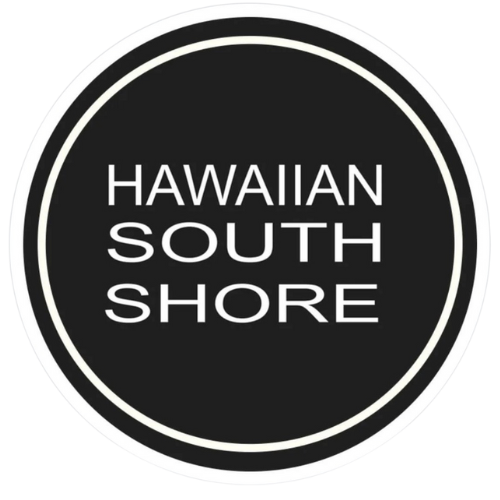Hawaiian South Shore June Newsletter
Share
KUROSHIO CURRENT AND ITS EFFECT ON THE WEATHER
David Kelly | Owner, Hawaiian South Shore
I’d never heard about the Kuroshio Current until a couple of days ago. My wife was watching a documentary, and asked me if I knew what it was, or that it was possibly the reason Hawaii has had such wonky weather over the past few months. Anything that can affect the weather (and by extension, the surf) has my interest, so I decided I’d better dive in and start researching the phenomenon.
 The Kuroshio Current is a north flowing current located near Japan. It is similar to the Gulf Stream, except that it’s located in the western Pacific instead of the western Atlantic. It is essentially the western part of the North Pacific Gyre, and typically flows in a pretty normal pattern.
But every once in a while, that pattern changes. Five times in the past 50 years, the current has deviated from its normal path, the last deviation being in 2005. But now, for the first time in 12 years, the Kuroshio Current is deviating from its normal pattern, and that has a lot to do with the strange weather Japan (and other areas) have been experiencing this year.
The interesting thing is that this was actually forecasted. Weather experts have become pretty good at predicting Kuroshio Current deviations, and in 2017 it was predicted that the current would go askew this year and affect the weather in the Pacific. The current is expected to remain anomalous into the winter of 2018, and for Japan that means a lot more snow than normal, higher tides, and the potential for big typhoons, tides, and flooding.
For Hawaii, the effects of a deviating Kuroshio Current are more difficult to pinpoint, but no one will argue that this has been a pretty strange winter/spring, with a lot of weird winds, incessant rain, and pretty average surf. It stands to reason that any major shift in normal currents and weather conditions in the Pa- cific will alter weather and swell patterns in Hawaii, and that might just be what we’ve been seeing over the past few months.
Hopefully the Kuroshio Current doesn’t affect south swells, because summer is here, and we are due for a southern hemi season!
The Kuroshio Current is a north flowing current located near Japan. It is similar to the Gulf Stream, except that it’s located in the western Pacific instead of the western Atlantic. It is essentially the western part of the North Pacific Gyre, and typically flows in a pretty normal pattern.
But every once in a while, that pattern changes. Five times in the past 50 years, the current has deviated from its normal path, the last deviation being in 2005. But now, for the first time in 12 years, the Kuroshio Current is deviating from its normal pattern, and that has a lot to do with the strange weather Japan (and other areas) have been experiencing this year.
The interesting thing is that this was actually forecasted. Weather experts have become pretty good at predicting Kuroshio Current deviations, and in 2017 it was predicted that the current would go askew this year and affect the weather in the Pacific. The current is expected to remain anomalous into the winter of 2018, and for Japan that means a lot more snow than normal, higher tides, and the potential for big typhoons, tides, and flooding.
For Hawaii, the effects of a deviating Kuroshio Current are more difficult to pinpoint, but no one will argue that this has been a pretty strange winter/spring, with a lot of weird winds, incessant rain, and pretty average surf. It stands to reason that any major shift in normal currents and weather conditions in the Pa- cific will alter weather and swell patterns in Hawaii, and that might just be what we’ve been seeing over the past few months.
Hopefully the Kuroshio Current doesn’t affect south swells, because summer is here, and we are due for a southern hemi season!
TRANSITIONING FROM YOUR FIRST LONGBOARD TO YOUR FIRST SHORTBOARD When first learning to surf, many people choose to learn on longboards, as they offer better paddle power and more stability, which makes it easier to learn the fundamentals of wave riding. But after a couple years of surfing, many people decide that they’d like to graduate to a shorter and more aggressive board, which lends itself to surfing bigger, hollower waves, and to performing more aggressive high-performance maneuvers. Variety in your quiver always makes you a better surfer, but when transitioning to a smaller board, it is important to keep a few things in mind. First of all, your shorter board is going to paddle a lot slower. Less volume means less flotation, so your board will be farther underwater when you paddle and will not travel as fast through the water. Thus, when moving down in length, it may be wise to look for a board that still maintains a decent amount of volume. Good examples are the Libtech Pickup Stick, which comes in 7’6” and 7’0” models. While these boards are shorter than your average longboard, they maintain a full template through the nose, which keeps the volume up so that you can paddle faster and get into waves earlier. Another thing to keep in mind is that your shorter board will ride faster and be more responsive. While this is a good thing, it can be a bit difficult to get used to at first. For lighter-weight surfers who want to move to a shorter board, try the Libtech Extension Ramp in a 6’6” size. This is a lot closer to today’s high-performance boards than the longboard you are graduating from, but it still has a bit of forgiveness in its rails and is a full-enough template that it is user-friendly. When you decide that it’s time to try out a shorter board, try not to get into the mindset that this is your new “only” way to surf. There are as many different types of boards to ride as there are conditions to ride them in. Just because you can ride a shortboard doesn’t mean you always should. When the conditions call for high-performance ripping, then by all means, pull out that shredstick. But when the waves are small and cruisy, it’s a good chance to remind yourself that longboards are for more than learning. And whatever you end up riding, remember to have fun!
A CHANCE TO TALK STORY WITH CJ NELSON AND HARLEY INGLEBY Saturday, July 14, 2018 – 3:30 PM at Hawaiian South Shore One of the most unique and exciting things about surfing is that it is one of the few sports where we often have the chance to meet and play with our heroes. Michael Jordan never shows up at a local basketball court for a game of pick-up, and it’s virtually impossible to get an audience with the founder of Nike, but on any given day you can share waves with a pro surfer at your local spot or stop into a shop to chat with a legendary shaper. This small, close-knit community is what makes surfing such a special sport and is why we opened Hawaiian South Shore nearly two decades ago. On Saturday, July 14th at 3:30 PM, we will be fortunate enough to have not one, but two legends of the sport stop by the shop. CJ Nelson and Harley Ingleby are two of the best longboarders in the business. Known for both their traditional noseriding abilities and their progressive, competitive successes. Both surfers will be spending the evening at the shop to talk about their various models, plus do a meet and greet with surf fans and surfboard aficionados. Yu Sumitomo (the man behind the revolutionary Thunderbolt technology that is used in the CJ Nelson Designs and Harley Ingleby models) will also be there, as will the crew from Carve Sports, which is the US distributor for Thunderbolt Technology.
 In addition to an evening of talking story with the pros, we will also have a bunch of the CJ Nelson and Harley Ingleby boards available for people to check out, including the new Wayne Rich model known as the Haven. Rainbow Drive-In will be serving food, and hopefully the Pacific will be serving up a dose of south swell as well!
In addition to an evening of talking story with the pros, we will also have a bunch of the CJ Nelson and Harley Ingleby boards available for people to check out, including the new Wayne Rich model known as the Haven. Rainbow Drive-In will be serving food, and hopefully the Pacific will be serving up a dose of south swell as well!


 This is shaping up to be one of the most exciting events of the summer on Oahu, and we are thrilled to be able to host it. Whether you are interested in board design, board construction, tasty grindz, or simply meeting two of longboarding’s most talented surfers, there will be something for just about everyone.
The event starts at 3:30 PM on Saturday, July 14th at Hawaiian South Shore. If there are any questions you might have for CJ Nelson or Harley Ingleby, come down and let’s make a day out of it!
This is shaping up to be one of the most exciting events of the summer on Oahu, and we are thrilled to be able to host it. Whether you are interested in board design, board construction, tasty grindz, or simply meeting two of longboarding’s most talented surfers, there will be something for just about everyone.
The event starts at 3:30 PM on Saturday, July 14th at Hawaiian South Shore. If there are any questions you might have for CJ Nelson or Harley Ingleby, come down and let’s make a day out of it!
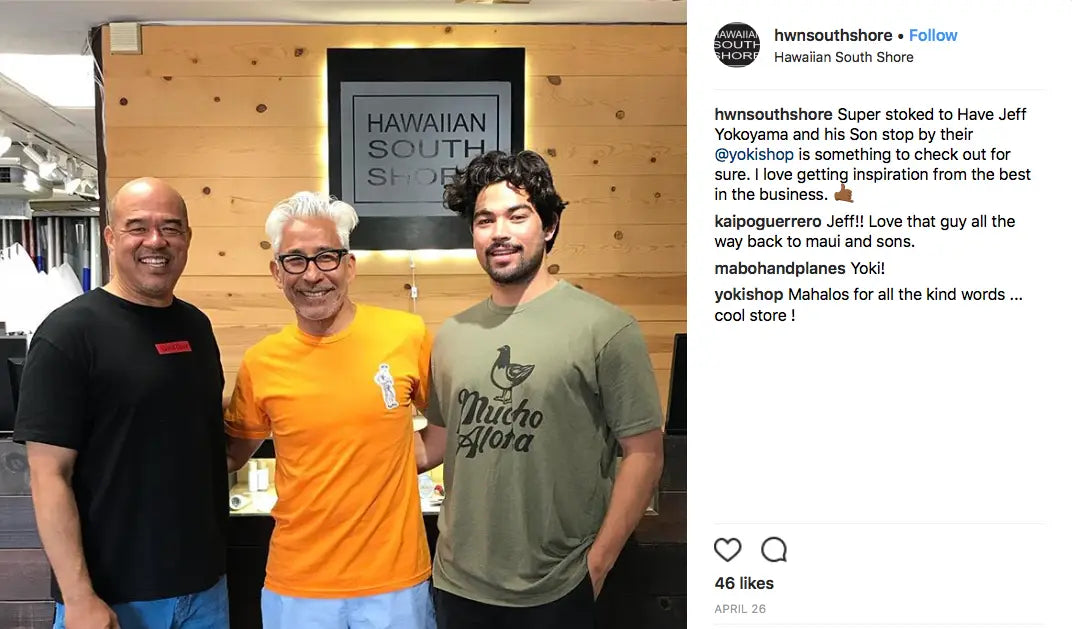 When Stephen Schatz came in asking about a board I thought he was Brian Schatz, the US Senator, but Stephen is his twin brother.
Stephen demoed a Libtech and he was blown away in surprise with the flow and performance, he picked up a Puddle Jumper.
I’m glad we have demos available because many that have not transitioned down to a shorter board or have had bad experiences with shorter boards, this gives them a chance to demo one.
When Stephen Schatz came in asking about a board I thought he was Brian Schatz, the US Senator, but Stephen is his twin brother.
Stephen demoed a Libtech and he was blown away in surprise with the flow and performance, he picked up a Puddle Jumper.
I’m glad we have demos available because many that have not transitioned down to a shorter board or have had bad experiences with shorter boards, this gives them a chance to demo one.
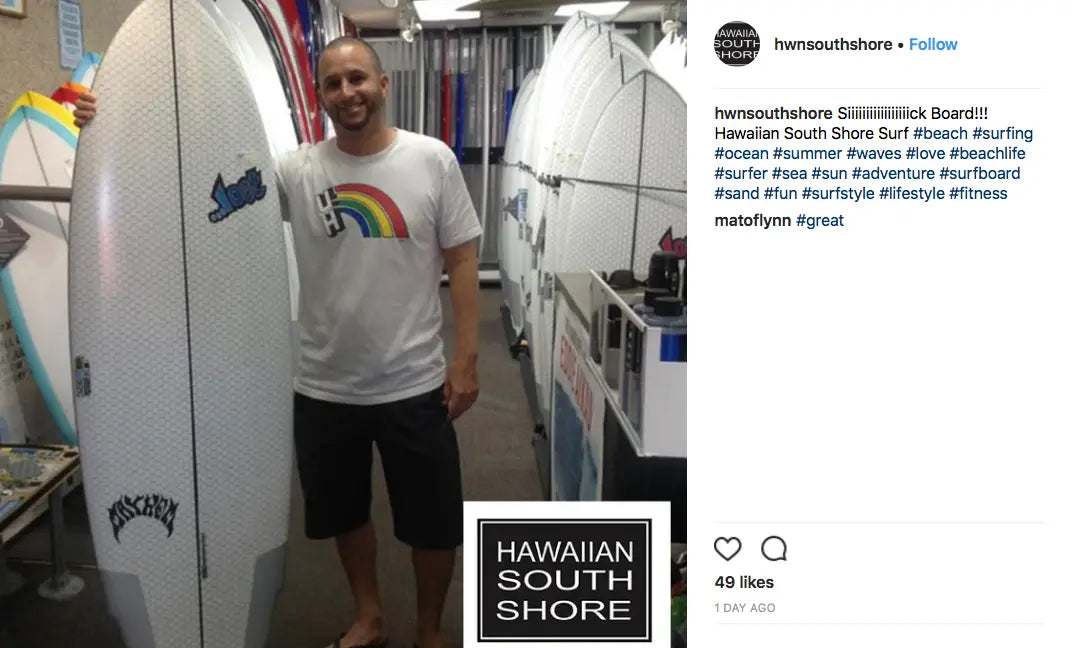 We recently got a shipment of some nice Pink Aloha Print Takayama Halo fins. The color came out muted, so it looks kind of retro, so it looks really nice. When we posted this Halo Fin with the Pink Aloha Fabric we didn’t expect the reaction to be this big. The people that like pink came out of the wood work and snagged them up.
We recently got a shipment of some nice Pink Aloha Print Takayama Halo fins. The color came out muted, so it looks kind of retro, so it looks really nice. When we posted this Halo Fin with the Pink Aloha Fabric we didn’t expect the reaction to be this big. The people that like pink came out of the wood work and snagged them up.
 Stephanie Light (@stephanie.mae.light) picked up a pink one after seeing it on Instagram. We recommended the 9.5” Halo fin for her 9’6” Single Fin Long- board. A few days later I DM’d her she said: “seriously made such a big differ- ence in my turns...and I felt an increase in speed too compared to my other fin I had before. It’s amazing! ”
YEAH…I love it and that’s why it’s been our #1 selling fin for 15 years! Super stoked. – David
We love getting reviews, it help us get better at what we do. If you have a review, send it via IG, FB or just an email would be really helpful, plus we can show other surfers and be able to help them make the right choice, whether it’s for a fin or anything else.
Stephanie Light (@stephanie.mae.light) picked up a pink one after seeing it on Instagram. We recommended the 9.5” Halo fin for her 9’6” Single Fin Long- board. A few days later I DM’d her she said: “seriously made such a big differ- ence in my turns...and I felt an increase in speed too compared to my other fin I had before. It’s amazing! ”
YEAH…I love it and that’s why it’s been our #1 selling fin for 15 years! Super stoked. – David
We love getting reviews, it help us get better at what we do. If you have a review, send it via IG, FB or just an email would be really helpful, plus we can show other surfers and be able to help them make the right choice, whether it’s for a fin or anything else.
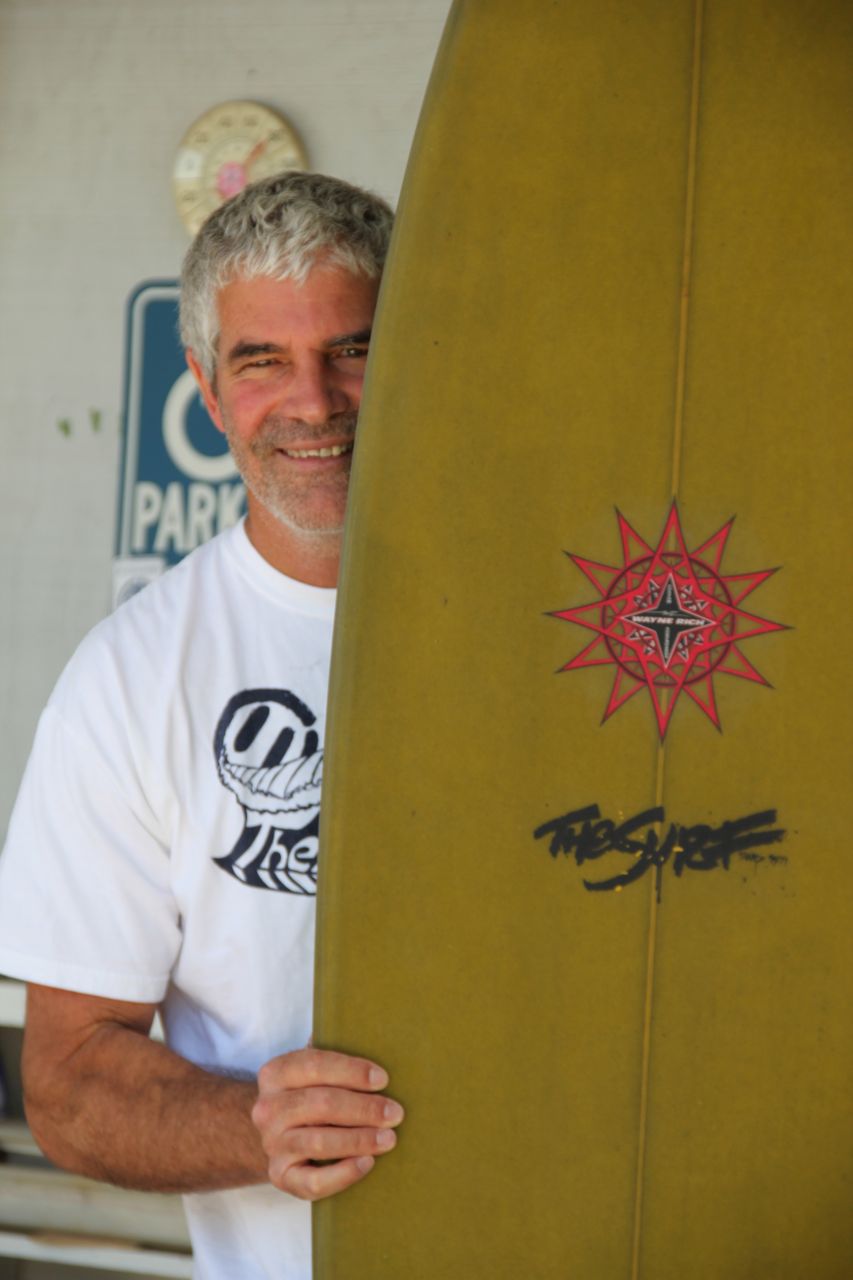 When it comes to the history of surfboard design, there are a lot of important names out there. Names like Bing, Webber, Noll, Becker, Yater, Miyata, and Bradbury, amongst others. These innovators not only shaped the boards that we ride, but the surfboard industry as a whole. If it were possible to collate the combined knowledge of these surfboard titans, you’d have a veritable encyclope- dia of hydrodynamics, shaping techniques, and plain old surf history.
As it turns out, that encyclopedia exists, in the form of Santa Barbara shaper Wayne Rich. Rich grew up under the tutelage of all of the legendary shapers listed above, in addition to dozens of others. With mentors such as these,
it was only natural that he would develop into a leader in surfboard design. First in Hermosa Beach and then in the Ventura/Santa Barbara area, Rich has developed a loyal following of enthusiasts who come to him for his clean lines and classic designs, mixed with modern tweaks that make for some of the best longboards and mid-lengths on the market.
Rich has worked with some of the best athletes in the industry, including logging legend Joel Tudor, whose surfboard line included a number of Rich shapes over the years. With an established reputation amongst both pros and everyman surfers, Rich is a leading shaper, and his influence continues to grow 35 years after he first picked up a planer.
Most recently, Rich has begun to collaborate with CJ Nelson, considered by many to be the best traditional noserider of the modern era. Nelson has developed a line of modern traditional longboards that blend the best design elements from decades of longboard refinement with space age technology such as carbon fiber, XEON fiberglass, multi-directional weave/layup laminations, flex noses, and twist tails.
When it comes to the history of surfboard design, there are a lot of important names out there. Names like Bing, Webber, Noll, Becker, Yater, Miyata, and Bradbury, amongst others. These innovators not only shaped the boards that we ride, but the surfboard industry as a whole. If it were possible to collate the combined knowledge of these surfboard titans, you’d have a veritable encyclope- dia of hydrodynamics, shaping techniques, and plain old surf history.
As it turns out, that encyclopedia exists, in the form of Santa Barbara shaper Wayne Rich. Rich grew up under the tutelage of all of the legendary shapers listed above, in addition to dozens of others. With mentors such as these,
it was only natural that he would develop into a leader in surfboard design. First in Hermosa Beach and then in the Ventura/Santa Barbara area, Rich has developed a loyal following of enthusiasts who come to him for his clean lines and classic designs, mixed with modern tweaks that make for some of the best longboards and mid-lengths on the market.
Rich has worked with some of the best athletes in the industry, including logging legend Joel Tudor, whose surfboard line included a number of Rich shapes over the years. With an established reputation amongst both pros and everyman surfers, Rich is a leading shaper, and his influence continues to grow 35 years after he first picked up a planer.
Most recently, Rich has begun to collaborate with CJ Nelson, considered by many to be the best traditional noserider of the modern era. Nelson has developed a line of modern traditional longboards that blend the best design elements from decades of longboard refinement with space age technology such as carbon fiber, XEON fiberglass, multi-directional weave/layup laminations, flex noses, and twist tails.
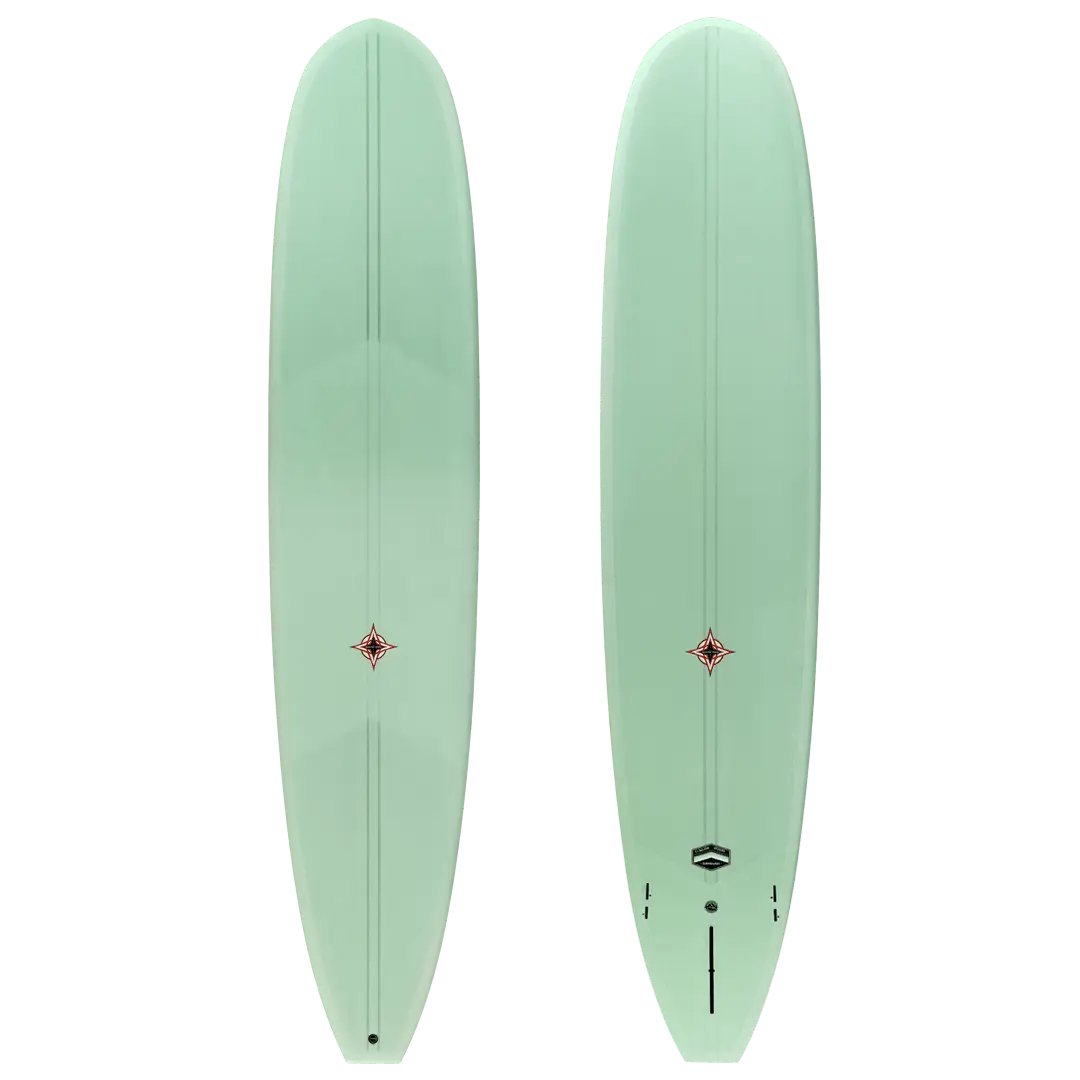 The Haven is Rich’s contribution to the CJ Nelson Designs quiver. Combining performance rails with ultra-modern rocker concepts, a wide, concaved nose for tip time, and aggressive rail edge in the board’s tail, this longboard is built to do just about everything, in every condition. It noserides well, carves the face, and even caters to those who need a more user-friendly design. For those looking to take their surfing to the next level with a one-board quiver reinforced with the latest in construction technology, the Haven is Wayne Rich’s answer… and the obvious choice.
The Haven is Rich’s contribution to the CJ Nelson Designs quiver. Combining performance rails with ultra-modern rocker concepts, a wide, concaved nose for tip time, and aggressive rail edge in the board’s tail, this longboard is built to do just about everything, in every condition. It noserides well, carves the face, and even caters to those who need a more user-friendly design. For those looking to take their surfing to the next level with a one-board quiver reinforced with the latest in construction technology, the Haven is Wayne Rich’s answer… and the obvious choice.
STAYING SAFE UNDER HAWAII’S NEW SUNSCREEN LAW For those of us who grew up around the ocean, especially in the tropics, coral reefs are a way of life. We surf over them, snorkel through them, fish from them, and yes, occasionally scrub chunks of them out of cuts. The colorful diversity of coral is something we have all wondered at, particularly when we’ve had the chance to get up close and personal with healthy, living coral, and seen that it really is a massive colony of living organisms. Coral plays an integral role in the health of our oceans, the shape of our waves, and the state of our tourism-driven economy. Unfortunately, a variety of factors are contributing to the ongoing bleaching of coral, a process that is happen- ing at an accelerated rate all over the world. One of those factors is pollution and that’s something the state of Hawaii is now working to control. Millions of tourists come to Hawaii every year, and those millions of tourists use a lot of sunscreen. No one wants to get roasted during their yearly holiday, but some studies have shown that oxybenzone and octinoxate, two chemicals that are present in around 70% of commercial sunscreens, may damage coral reefs. With the health of Hawaii’s coral being an important draw for tourists, the Hawaii State Legislature recently approved a bill that will outlaw any sunscreens containing either of these chemicals. If that bill is signed into law by Governor David Ige, it would phase out use of any sunscreens containing oxybenzone and octinoxate by 2021, making Hawaii the first place to ban such products. Those with fair complexions might be wondering how they are supposed to avoid getting sunburned during their next visit to Hawaii, but fortunately there are a number of sunscreens out there that don’t contain these harmful chemicals. One such product is Real Sun Cover Sunscreen, an organic sunscreen that is made in the USA. It uses simple ingredients that you can pronounce and understand, not harmful chemicals that are toxic to your skin and the coral.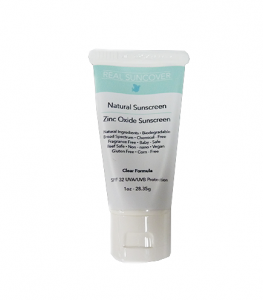
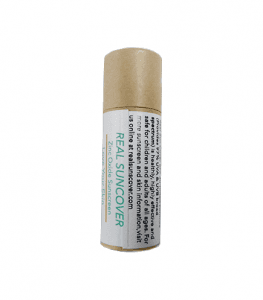
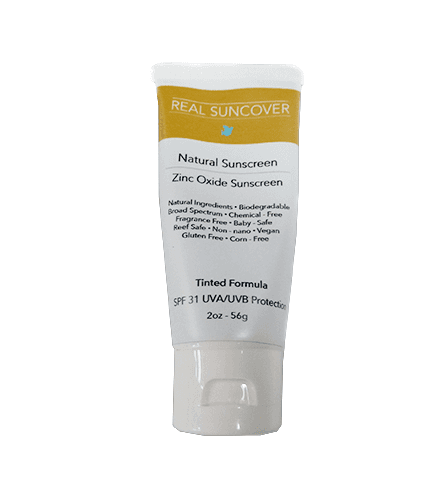
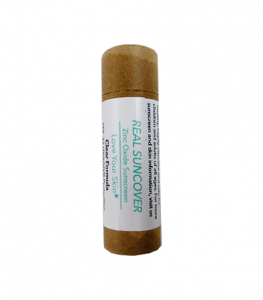 Real Sun Cover Sunscreen sits on top of the skin rather than absorbing into it and uses organic zinc oxide as its base. It blocks both UVA and UVB rays, is fragrance free and safe for babies, and is of course reef safe, meaning that you will be able to use it once Hawaii’s sunscreen ban law goes into effect.
Real Sun Cover Sunscreen is SPF32 which equals to 97.2% UVA / UVB protection. I know you think SP50 is the best but it’s only a 1% difference. So, going all nat- ural is a better choice. Plus, if you’re looking to save your skin while following the letter of the new law, Real Sun Cover Sunscreen just might be the answer!
REAL SUN COVER SPECIAL: Purchase a Real Sun Cover, use it, then give us an honest review on what you think about the Sun Cover. Send it via email or drop off a letter with at least 150 words and we will give you a FREE REAL SUN COVER (equal value or less) for taking the time to give us your review. You need to turn in your Review by July 10, 2018 7:00P.M. HST.
Real Sun Cover Sunscreen sits on top of the skin rather than absorbing into it and uses organic zinc oxide as its base. It blocks both UVA and UVB rays, is fragrance free and safe for babies, and is of course reef safe, meaning that you will be able to use it once Hawaii’s sunscreen ban law goes into effect.
Real Sun Cover Sunscreen is SPF32 which equals to 97.2% UVA / UVB protection. I know you think SP50 is the best but it’s only a 1% difference. So, going all nat- ural is a better choice. Plus, if you’re looking to save your skin while following the letter of the new law, Real Sun Cover Sunscreen just might be the answer!
REAL SUN COVER SPECIAL: Purchase a Real Sun Cover, use it, then give us an honest review on what you think about the Sun Cover. Send it via email or drop off a letter with at least 150 words and we will give you a FREE REAL SUN COVER (equal value or less) for taking the time to give us your review. You need to turn in your Review by July 10, 2018 7:00P.M. HST.
MEMBER OF THE MONTH Michael Chang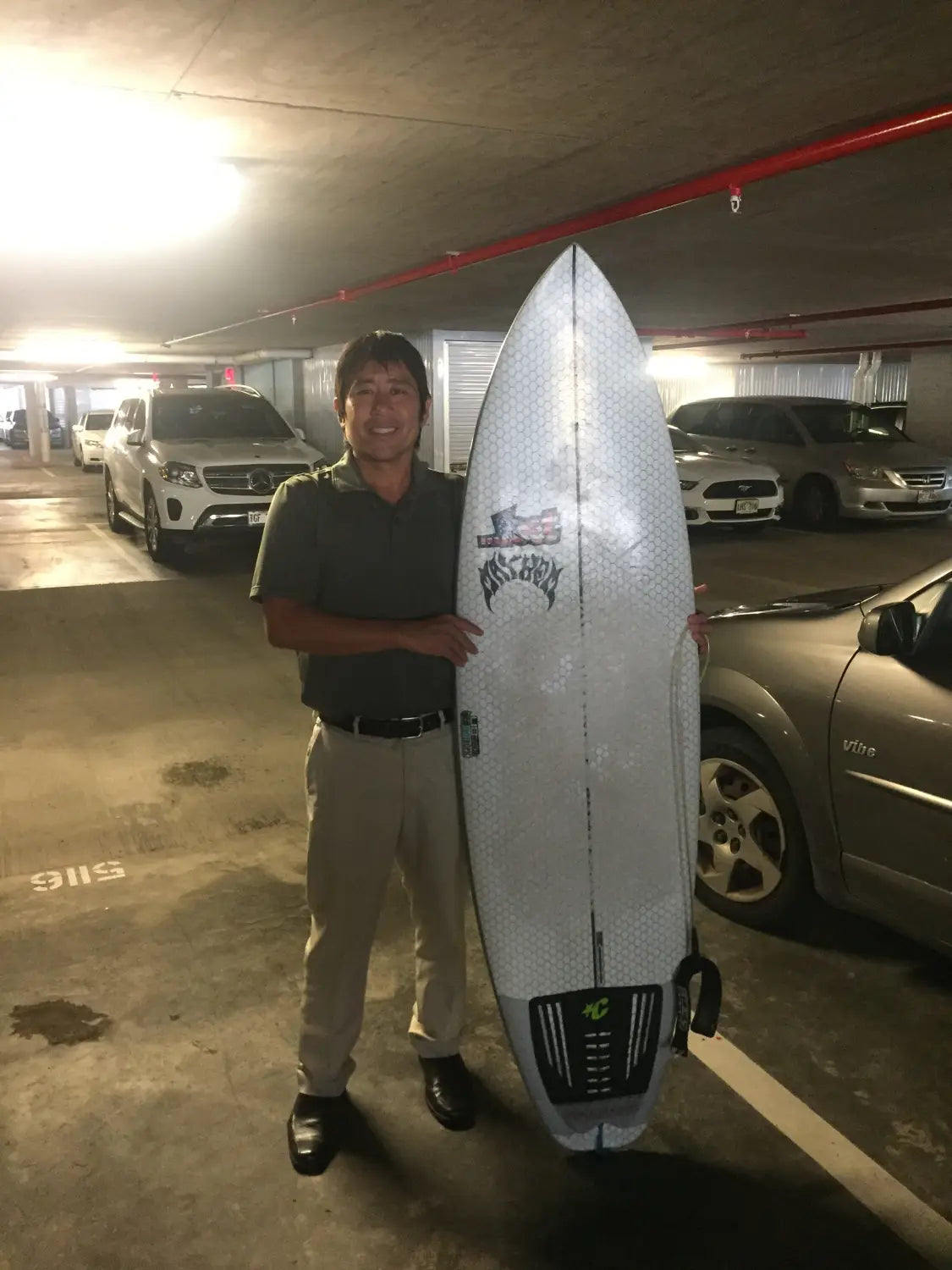 I’m originally from New York City and about thirty years ago over there, I met a guy from the Barbados who offered to take me surfing a couple times. He put me on a little short-board and I hadn’t really spent any time in the ocean before, so I never caught any waves and thought surfing was impossibly hard.
So, I moved to Hawaii about 20 years ago, I had no thoughts of surfing, but then someone took me to Waikiki and put me on a longboard and I was hooked.
About a year ago, I bought a 6’2” Lost Libtech Short Round from Hawaiian South Shore. It’s a great all around board. I really don’t have space for a quiver and in the building I live in, it’s a hassle to switch out boards, so it’s nice having a good all-around board.
It’s a lot of volume for me; most guys my size use smaller boards, but at this time, I’d rather have less maneuverability if I can get more waves. I usually use the thruster setup, but I’ve been trying quad recently. The first time I tried the quad setup, it felt too loose, but I’m starting to like it now.
I’m originally from New York City and about thirty years ago over there, I met a guy from the Barbados who offered to take me surfing a couple times. He put me on a little short-board and I hadn’t really spent any time in the ocean before, so I never caught any waves and thought surfing was impossibly hard.
So, I moved to Hawaii about 20 years ago, I had no thoughts of surfing, but then someone took me to Waikiki and put me on a longboard and I was hooked.
About a year ago, I bought a 6’2” Lost Libtech Short Round from Hawaiian South Shore. It’s a great all around board. I really don’t have space for a quiver and in the building I live in, it’s a hassle to switch out boards, so it’s nice having a good all-around board.
It’s a lot of volume for me; most guys my size use smaller boards, but at this time, I’d rather have less maneuverability if I can get more waves. I usually use the thruster setup, but I’ve been trying quad recently. The first time I tried the quad setup, it felt too loose, but I’m starting to like it now.
HEALTH AND NUTRITION FOR SURFERS They say that you are what you eat, and the same holds true for surfers just as it does for everyone else. Although we often think of it simply as a fun pastime or hobby, surfing is a sport, and the more fine-tuned your body is, the better you will perform (and the more fun you will have!). This involves more than just training—particularly as you get older, your diet is actually the most important factor in your health and body composition. A few decades ago, pro surfers were better known for partying than they were for training and eating right, but these days the guys at the top are super health conscious, and many even have dieticians. There are reports in the media that Kelly Slater recently went vegan, and Laird Hamilton is famous for saying that pizza is the devil. But you don’t have to be a big-wave pioneer or the greatest surfer in the world to fuel your body properly. The average surfer can paddle out primed and ready to shred by following a few simple diet rules. 1) Hydrate! Nothing interferes with physical performance more than dehydration, and since the ocean is salty, it's a very easy place to get dehydrated. Drink a lot of water and/or electrolyte drinks before surfing, and again right after your session. Try to avoid drinking anything with lots of sugar or chemicals (that includes a lot of energy drinks and soda, but even too much fruit juice). These might give you a quick kick of energy at first, but the high glycemic index means you will crash shortly after. Assuming you want to catch more than just a few waves in your session, load up on water, then get your nutrients and calories from real food. 2) Fuel with healthy fats and healthy carbs: Fats aren’t a bad thing, as long as you are getting them from healthy sources. Many pro surfers have diets that include healthy fats such as avocado, olive oil, and nuts, as these foods give you slow-burning energy that last a long Likewise, complex carbohy- drates such as those found in vegetables, fruits, and whole grains tend to stick with you longer than processed carbs such as white flour and white rice, which are largely just empty calories. Make sure you eat enough to fuel you for your entire session. When the waves are pumping, you probably won’t want to paddle in for lunch, but you also don’t want to run out of energy halfway through your session. 3) Recover with protein and nutrients. Physical activity breaks down the body, which isn’t actually a bad thing, since the recovery process from this breakdown is what makes us get stronger and develop more muscle and cardiac ability. But in order to properly recover, you have to provide your body with the nutrients it needs to rebuild. These include protein (to rebuild muscle) and vitamins and minerals, most of which are available in green leafy vege- tables and a variety of fruits and veggies. Whenever possible, opt for healthy and lean proteins, such as eggs, responsibly harvested fish, and lean meats if they are part of your diet. Replace rice or other starches with quinoa, which has a better protein-to-carb ratio. Add in kale, broccoli, spinach, and a variety of fruits and veggies to round out your meal—but if possible, don’t remove the skins, which are where a lot of the nutrients and fiber are stored. 4) Power up with a smoothie: Juicing is a trendy topic in the health world these days, but the reality is that while juicing does give you high doses of condensed nutrients, it also gives you a huge amount of sugar, since you are basically removing the fruit and vegetables’ sugars from the Top athletes know that unless you are fasting, you probably want to go with blending instead of juicing. Blending gives you all of the nutrients of fruits, but without skyrocketing your glycemic index by eliminating the fiber. There are nearly infinite smoothie recipes you can come up with, including green smoothies, fruit smoothies, and those that include protein powders and even probiotics such as kefir. 5) Time your meals properly: Ask any big wave surfer, and they’ll tell you that when you eat is just as important as When heading out into XXL waves, you can pretty much assume that your session is going to last all day. After all, even the best in the world only manage to catch a handful of waves when the swell is huge, so the longer you can stay out the better. That means fueling adequately for the day by having a big, healthy breakfast. But the last thing you want to do is take a 20-footer on the head 20 minutes after you filled your belly. Most guys are up long before dawn when preparing for big wave sessions, and will make sure they eat that big, healthy dinner a few hours before they are going to paddle out. You can then power up with a smoothie or a healthy bar or two shortly before go-time. 6) What about superfoods? Superfoods are all the rage these days, from acai to kale to hempseed and chia, all of which can be pretty expensive. So, what’s the big deal, anyway? Here’s the thing: Superfoods don’t exist. They are just normal, natural, healthy foods that we should be eating no matter What makes them super? The fact that they aren’t processed, preser- vative-laden, microwave dinners full of way more sodium and animal products than we can healthily handle. Yes, acai and kale are superfoods. So are the mangos growing in your front yard, the carrots growing at your local farm, the quinoa you can buy at the store, and just about anything else that isn’t pro- cessed and packaged to the point that it loses its ability to be nutritious. Eat whole foods (veggies, fruits, whole grains, and responsibly caught, lean fish and meats) and avoid sugar, chemicals, preservatives, and too much sodium and saturated fat, and guess what? You won’t have to add superfoods to your diet. It will already be full of them. 7) Don’t forget exercise. While diet plays a major role in your health and ability to perform physically (especially after the age of 40), it isn’t the only fac- tor to keep in As we get older, it is no longer enough to simply surf for fit- ness, we need to train and stretch so that we can surf for life. Supplement your surfs with cardio workouts to keep your heart strong and your weight down. That way, you won’t have to sacrifice the performance of your boards in order to accommodate your excess weight. Think about integrating some type of light strength training into your routine, or at the very least work with a Thera- band to keep your rotator cuffs strong. And most importantly, explore yoga or other forms of stretching, which will help you remain limber and mobile, and help to prevent injuries. The goal isn’t just to surf for the rest of your life, it’s to enjoy doing so. And a happy, healthy body is a major step in the right direction.
COREY COLAPINTO AND HIS CRUISY COLAPINTAIL Corey Colapinto isn’t your normal longboarder. In fact, he started out on a shortboard, and spent many years chasing competitive success in shortboard events. But it was his skills on a log that brought Corey the most attention, and that resulted in sponsorships and the ability to surf full time.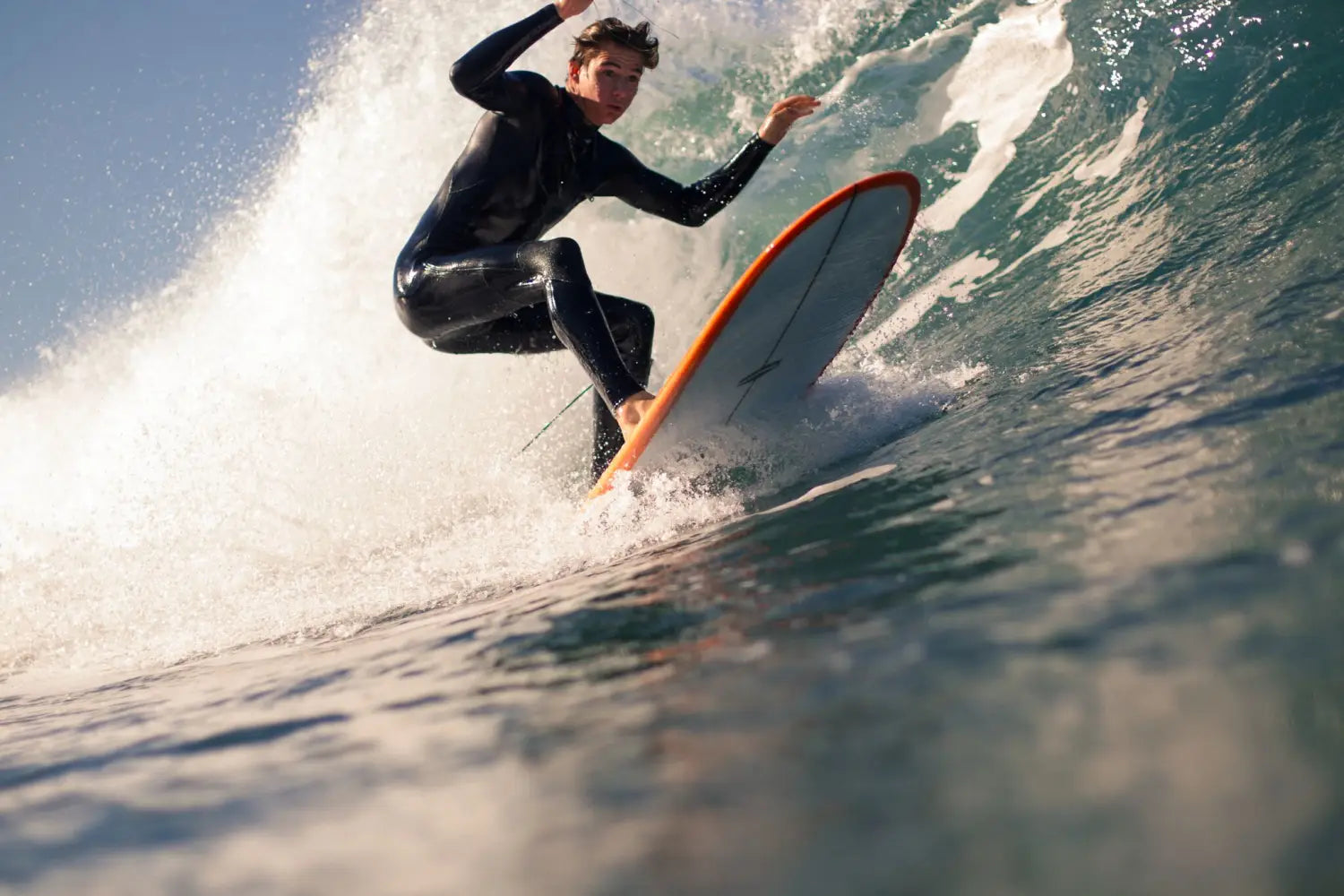 In addition to spending as much time as possible on the nose, Corey also puts in his time designing boards, and his Colapintail model is a favorite of ours. Developed in partnership with shaper Ryan Engle, and originally inspired Wayne Lynch’s boards and surfing during the shortboard revolution, this board has evolved to include down rails and a double concave/spiral vee in the tail, making it a versatile mid-length that can turn, trim, and noseride. The Colapintail is a staple in the CJ Nelson Designs quiver and comes stock at 8’3” and 8’9”, with carbon fiber, XEON, and traditional fiberglass options. For those looking to mix the flow of a log with the radical approach of a shortboard, the Colapintail puts the “fun” in “funboard.” Come down to the shop and demo one today!
In addition to spending as much time as possible on the nose, Corey also puts in his time designing boards, and his Colapintail model is a favorite of ours. Developed in partnership with shaper Ryan Engle, and originally inspired Wayne Lynch’s boards and surfing during the shortboard revolution, this board has evolved to include down rails and a double concave/spiral vee in the tail, making it a versatile mid-length that can turn, trim, and noseride. The Colapintail is a staple in the CJ Nelson Designs quiver and comes stock at 8’3” and 8’9”, with carbon fiber, XEON, and traditional fiberglass options. For those looking to mix the flow of a log with the radical approach of a shortboard, the Colapintail puts the “fun” in “funboard.” Come down to the shop and demo one today!
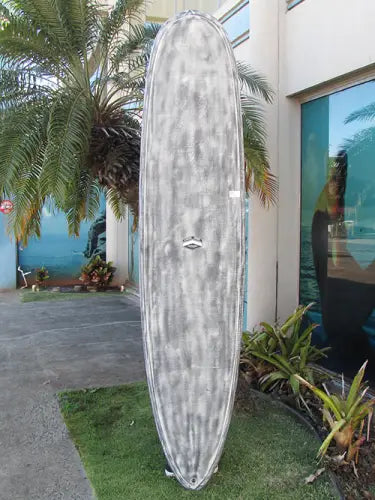
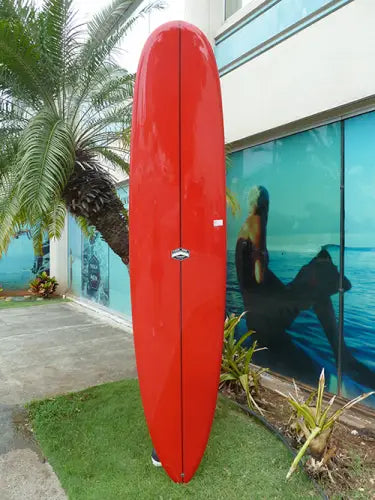
DEMO BOARDS AVAILABLE TO TRY BEFORE YOU BUY!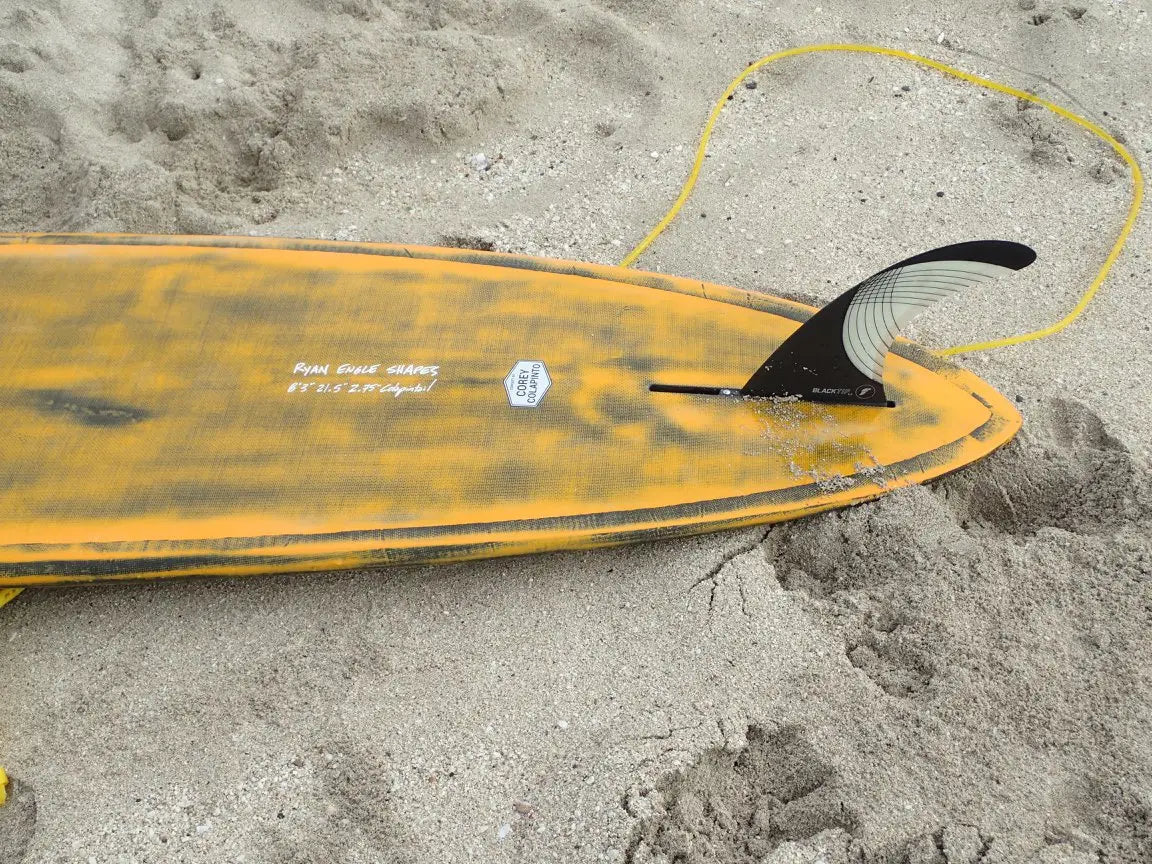
FOLLOW @hwnsouthshore ON INSTAGRAM!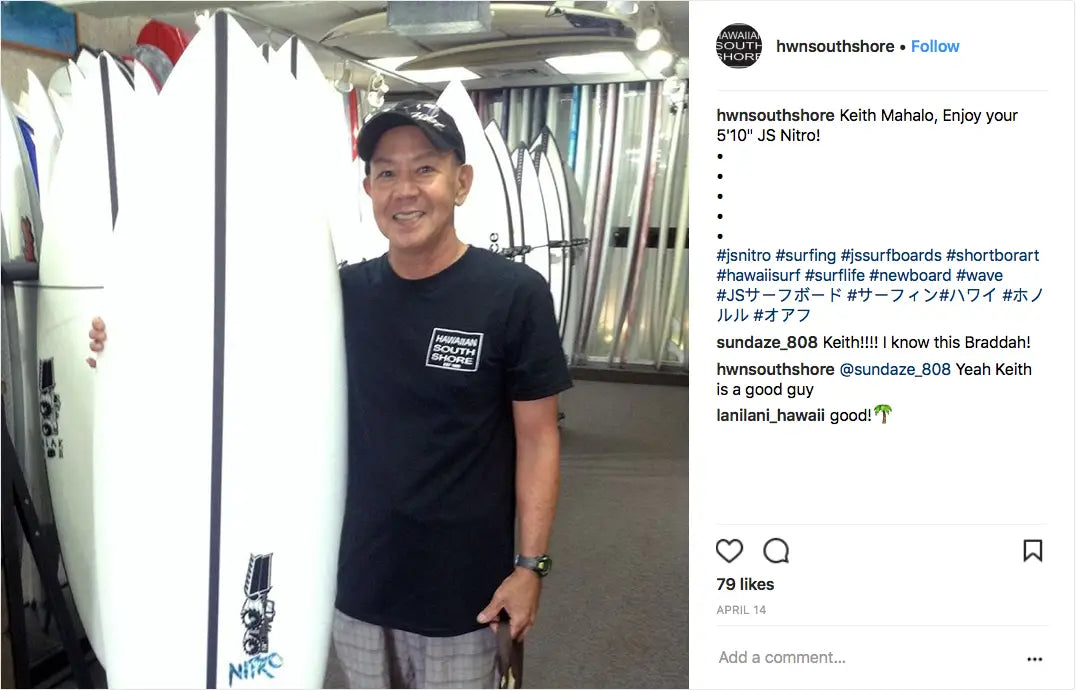 This is our Good Friend Keith, picking up a JS Psycho Nitro. So many see this boards outline and instantly fall in love with the shape. I personally have this board and it's fast, loose and skatey, perfect for town.
This is our Good Friend Keith, picking up a JS Psycho Nitro. So many see this boards outline and instantly fall in love with the shape. I personally have this board and it's fast, loose and skatey, perfect for town.
 SaveSave
SaveSave
SaveSave
SaveSave
 The Kuroshio Current is a north flowing current located near Japan. It is similar to the Gulf Stream, except that it’s located in the western Pacific instead of the western Atlantic. It is essentially the western part of the North Pacific Gyre, and typically flows in a pretty normal pattern.
But every once in a while, that pattern changes. Five times in the past 50 years, the current has deviated from its normal path, the last deviation being in 2005. But now, for the first time in 12 years, the Kuroshio Current is deviating from its normal pattern, and that has a lot to do with the strange weather Japan (and other areas) have been experiencing this year.
The interesting thing is that this was actually forecasted. Weather experts have become pretty good at predicting Kuroshio Current deviations, and in 2017 it was predicted that the current would go askew this year and affect the weather in the Pacific. The current is expected to remain anomalous into the winter of 2018, and for Japan that means a lot more snow than normal, higher tides, and the potential for big typhoons, tides, and flooding.
For Hawaii, the effects of a deviating Kuroshio Current are more difficult to pinpoint, but no one will argue that this has been a pretty strange winter/spring, with a lot of weird winds, incessant rain, and pretty average surf. It stands to reason that any major shift in normal currents and weather conditions in the Pa- cific will alter weather and swell patterns in Hawaii, and that might just be what we’ve been seeing over the past few months.
Hopefully the Kuroshio Current doesn’t affect south swells, because summer is here, and we are due for a southern hemi season!
The Kuroshio Current is a north flowing current located near Japan. It is similar to the Gulf Stream, except that it’s located in the western Pacific instead of the western Atlantic. It is essentially the western part of the North Pacific Gyre, and typically flows in a pretty normal pattern.
But every once in a while, that pattern changes. Five times in the past 50 years, the current has deviated from its normal path, the last deviation being in 2005. But now, for the first time in 12 years, the Kuroshio Current is deviating from its normal pattern, and that has a lot to do with the strange weather Japan (and other areas) have been experiencing this year.
The interesting thing is that this was actually forecasted. Weather experts have become pretty good at predicting Kuroshio Current deviations, and in 2017 it was predicted that the current would go askew this year and affect the weather in the Pacific. The current is expected to remain anomalous into the winter of 2018, and for Japan that means a lot more snow than normal, higher tides, and the potential for big typhoons, tides, and flooding.
For Hawaii, the effects of a deviating Kuroshio Current are more difficult to pinpoint, but no one will argue that this has been a pretty strange winter/spring, with a lot of weird winds, incessant rain, and pretty average surf. It stands to reason that any major shift in normal currents and weather conditions in the Pa- cific will alter weather and swell patterns in Hawaii, and that might just be what we’ve been seeing over the past few months.
Hopefully the Kuroshio Current doesn’t affect south swells, because summer is here, and we are due for a southern hemi season!
TRANSITIONING FROM YOUR FIRST LONGBOARD TO YOUR FIRST SHORTBOARD When first learning to surf, many people choose to learn on longboards, as they offer better paddle power and more stability, which makes it easier to learn the fundamentals of wave riding. But after a couple years of surfing, many people decide that they’d like to graduate to a shorter and more aggressive board, which lends itself to surfing bigger, hollower waves, and to performing more aggressive high-performance maneuvers. Variety in your quiver always makes you a better surfer, but when transitioning to a smaller board, it is important to keep a few things in mind. First of all, your shorter board is going to paddle a lot slower. Less volume means less flotation, so your board will be farther underwater when you paddle and will not travel as fast through the water. Thus, when moving down in length, it may be wise to look for a board that still maintains a decent amount of volume. Good examples are the Libtech Pickup Stick, which comes in 7’6” and 7’0” models. While these boards are shorter than your average longboard, they maintain a full template through the nose, which keeps the volume up so that you can paddle faster and get into waves earlier. Another thing to keep in mind is that your shorter board will ride faster and be more responsive. While this is a good thing, it can be a bit difficult to get used to at first. For lighter-weight surfers who want to move to a shorter board, try the Libtech Extension Ramp in a 6’6” size. This is a lot closer to today’s high-performance boards than the longboard you are graduating from, but it still has a bit of forgiveness in its rails and is a full-enough template that it is user-friendly. When you decide that it’s time to try out a shorter board, try not to get into the mindset that this is your new “only” way to surf. There are as many different types of boards to ride as there are conditions to ride them in. Just because you can ride a shortboard doesn’t mean you always should. When the conditions call for high-performance ripping, then by all means, pull out that shredstick. But when the waves are small and cruisy, it’s a good chance to remind yourself that longboards are for more than learning. And whatever you end up riding, remember to have fun!
A CHANCE TO TALK STORY WITH CJ NELSON AND HARLEY INGLEBY Saturday, July 14, 2018 – 3:30 PM at Hawaiian South Shore One of the most unique and exciting things about surfing is that it is one of the few sports where we often have the chance to meet and play with our heroes. Michael Jordan never shows up at a local basketball court for a game of pick-up, and it’s virtually impossible to get an audience with the founder of Nike, but on any given day you can share waves with a pro surfer at your local spot or stop into a shop to chat with a legendary shaper. This small, close-knit community is what makes surfing such a special sport and is why we opened Hawaiian South Shore nearly two decades ago. On Saturday, July 14th at 3:30 PM, we will be fortunate enough to have not one, but two legends of the sport stop by the shop. CJ Nelson and Harley Ingleby are two of the best longboarders in the business. Known for both their traditional noseriding abilities and their progressive, competitive successes. Both surfers will be spending the evening at the shop to talk about their various models, plus do a meet and greet with surf fans and surfboard aficionados. Yu Sumitomo (the man behind the revolutionary Thunderbolt technology that is used in the CJ Nelson Designs and Harley Ingleby models) will also be there, as will the crew from Carve Sports, which is the US distributor for Thunderbolt Technology.

 In addition to an evening of talking story with the pros, we will also have a bunch of the CJ Nelson and Harley Ingleby boards available for people to check out, including the new Wayne Rich model known as the Haven. Rainbow Drive-In will be serving food, and hopefully the Pacific will be serving up a dose of south swell as well!
In addition to an evening of talking story with the pros, we will also have a bunch of the CJ Nelson and Harley Ingleby boards available for people to check out, including the new Wayne Rich model known as the Haven. Rainbow Drive-In will be serving food, and hopefully the Pacific will be serving up a dose of south swell as well!


 This is shaping up to be one of the most exciting events of the summer on Oahu, and we are thrilled to be able to host it. Whether you are interested in board design, board construction, tasty grindz, or simply meeting two of longboarding’s most talented surfers, there will be something for just about everyone.
The event starts at 3:30 PM on Saturday, July 14th at Hawaiian South Shore. If there are any questions you might have for CJ Nelson or Harley Ingleby, come down and let’s make a day out of it!
This is shaping up to be one of the most exciting events of the summer on Oahu, and we are thrilled to be able to host it. Whether you are interested in board design, board construction, tasty grindz, or simply meeting two of longboarding’s most talented surfers, there will be something for just about everyone.
The event starts at 3:30 PM on Saturday, July 14th at Hawaiian South Shore. If there are any questions you might have for CJ Nelson or Harley Ingleby, come down and let’s make a day out of it!
WHAT’S NEW. WHAT’S POPULAR. WHAT PEOPLE ARE TALKING ABOUT.
We were really stoked to have Jeff Yokoyama visit us. As soon as he came in, I knew who he was. If you don’t know who he is, most call him Yoki. He founded Maui and Sons, Pirate Surf, Modern Amusement, Generic Youth and Pidgin Orange, as well as consulting for brands like Stussy and Quiksilver. So, if you don’t know who he is I’m sure you know the brands. Pretty Awesome. Also, to get compliments about the shop from someone like this is really an honor. When Stephen Schatz came in asking about a board I thought he was Brian Schatz, the US Senator, but Stephen is his twin brother.
Stephen demoed a Libtech and he was blown away in surprise with the flow and performance, he picked up a Puddle Jumper.
I’m glad we have demos available because many that have not transitioned down to a shorter board or have had bad experiences with shorter boards, this gives them a chance to demo one.
When Stephen Schatz came in asking about a board I thought he was Brian Schatz, the US Senator, but Stephen is his twin brother.
Stephen demoed a Libtech and he was blown away in surprise with the flow and performance, he picked up a Puddle Jumper.
I’m glad we have demos available because many that have not transitioned down to a shorter board or have had bad experiences with shorter boards, this gives them a chance to demo one.
 We recently got a shipment of some nice Pink Aloha Print Takayama Halo fins. The color came out muted, so it looks kind of retro, so it looks really nice. When we posted this Halo Fin with the Pink Aloha Fabric we didn’t expect the reaction to be this big. The people that like pink came out of the wood work and snagged them up.
We recently got a shipment of some nice Pink Aloha Print Takayama Halo fins. The color came out muted, so it looks kind of retro, so it looks really nice. When we posted this Halo Fin with the Pink Aloha Fabric we didn’t expect the reaction to be this big. The people that like pink came out of the wood work and snagged them up.
 Stephanie Light (@stephanie.mae.light) picked up a pink one after seeing it on Instagram. We recommended the 9.5” Halo fin for her 9’6” Single Fin Long- board. A few days later I DM’d her she said: “seriously made such a big differ- ence in my turns...and I felt an increase in speed too compared to my other fin I had before. It’s amazing! ”
YEAH…I love it and that’s why it’s been our #1 selling fin for 15 years! Super stoked. – David
We love getting reviews, it help us get better at what we do. If you have a review, send it via IG, FB or just an email would be really helpful, plus we can show other surfers and be able to help them make the right choice, whether it’s for a fin or anything else.
Stephanie Light (@stephanie.mae.light) picked up a pink one after seeing it on Instagram. We recommended the 9.5” Halo fin for her 9’6” Single Fin Long- board. A few days later I DM’d her she said: “seriously made such a big differ- ence in my turns...and I felt an increase in speed too compared to my other fin I had before. It’s amazing! ”
YEAH…I love it and that’s why it’s been our #1 selling fin for 15 years! Super stoked. – David
We love getting reviews, it help us get better at what we do. If you have a review, send it via IG, FB or just an email would be really helpful, plus we can show other surfers and be able to help them make the right choice, whether it’s for a fin or anything else.
CHANNELING LEGENDARY MENTORS WITH WAYNE RICH
 When it comes to the history of surfboard design, there are a lot of important names out there. Names like Bing, Webber, Noll, Becker, Yater, Miyata, and Bradbury, amongst others. These innovators not only shaped the boards that we ride, but the surfboard industry as a whole. If it were possible to collate the combined knowledge of these surfboard titans, you’d have a veritable encyclope- dia of hydrodynamics, shaping techniques, and plain old surf history.
As it turns out, that encyclopedia exists, in the form of Santa Barbara shaper Wayne Rich. Rich grew up under the tutelage of all of the legendary shapers listed above, in addition to dozens of others. With mentors such as these,
it was only natural that he would develop into a leader in surfboard design. First in Hermosa Beach and then in the Ventura/Santa Barbara area, Rich has developed a loyal following of enthusiasts who come to him for his clean lines and classic designs, mixed with modern tweaks that make for some of the best longboards and mid-lengths on the market.
Rich has worked with some of the best athletes in the industry, including logging legend Joel Tudor, whose surfboard line included a number of Rich shapes over the years. With an established reputation amongst both pros and everyman surfers, Rich is a leading shaper, and his influence continues to grow 35 years after he first picked up a planer.
Most recently, Rich has begun to collaborate with CJ Nelson, considered by many to be the best traditional noserider of the modern era. Nelson has developed a line of modern traditional longboards that blend the best design elements from decades of longboard refinement with space age technology such as carbon fiber, XEON fiberglass, multi-directional weave/layup laminations, flex noses, and twist tails.
When it comes to the history of surfboard design, there are a lot of important names out there. Names like Bing, Webber, Noll, Becker, Yater, Miyata, and Bradbury, amongst others. These innovators not only shaped the boards that we ride, but the surfboard industry as a whole. If it were possible to collate the combined knowledge of these surfboard titans, you’d have a veritable encyclope- dia of hydrodynamics, shaping techniques, and plain old surf history.
As it turns out, that encyclopedia exists, in the form of Santa Barbara shaper Wayne Rich. Rich grew up under the tutelage of all of the legendary shapers listed above, in addition to dozens of others. With mentors such as these,
it was only natural that he would develop into a leader in surfboard design. First in Hermosa Beach and then in the Ventura/Santa Barbara area, Rich has developed a loyal following of enthusiasts who come to him for his clean lines and classic designs, mixed with modern tweaks that make for some of the best longboards and mid-lengths on the market.
Rich has worked with some of the best athletes in the industry, including logging legend Joel Tudor, whose surfboard line included a number of Rich shapes over the years. With an established reputation amongst both pros and everyman surfers, Rich is a leading shaper, and his influence continues to grow 35 years after he first picked up a planer.
Most recently, Rich has begun to collaborate with CJ Nelson, considered by many to be the best traditional noserider of the modern era. Nelson has developed a line of modern traditional longboards that blend the best design elements from decades of longboard refinement with space age technology such as carbon fiber, XEON fiberglass, multi-directional weave/layup laminations, flex noses, and twist tails.
 The Haven is Rich’s contribution to the CJ Nelson Designs quiver. Combining performance rails with ultra-modern rocker concepts, a wide, concaved nose for tip time, and aggressive rail edge in the board’s tail, this longboard is built to do just about everything, in every condition. It noserides well, carves the face, and even caters to those who need a more user-friendly design. For those looking to take their surfing to the next level with a one-board quiver reinforced with the latest in construction technology, the Haven is Wayne Rich’s answer… and the obvious choice.
The Haven is Rich’s contribution to the CJ Nelson Designs quiver. Combining performance rails with ultra-modern rocker concepts, a wide, concaved nose for tip time, and aggressive rail edge in the board’s tail, this longboard is built to do just about everything, in every condition. It noserides well, carves the face, and even caters to those who need a more user-friendly design. For those looking to take their surfing to the next level with a one-board quiver reinforced with the latest in construction technology, the Haven is Wayne Rich’s answer… and the obvious choice.
STAYING SAFE UNDER HAWAII’S NEW SUNSCREEN LAW For those of us who grew up around the ocean, especially in the tropics, coral reefs are a way of life. We surf over them, snorkel through them, fish from them, and yes, occasionally scrub chunks of them out of cuts. The colorful diversity of coral is something we have all wondered at, particularly when we’ve had the chance to get up close and personal with healthy, living coral, and seen that it really is a massive colony of living organisms. Coral plays an integral role in the health of our oceans, the shape of our waves, and the state of our tourism-driven economy. Unfortunately, a variety of factors are contributing to the ongoing bleaching of coral, a process that is happen- ing at an accelerated rate all over the world. One of those factors is pollution and that’s something the state of Hawaii is now working to control. Millions of tourists come to Hawaii every year, and those millions of tourists use a lot of sunscreen. No one wants to get roasted during their yearly holiday, but some studies have shown that oxybenzone and octinoxate, two chemicals that are present in around 70% of commercial sunscreens, may damage coral reefs. With the health of Hawaii’s coral being an important draw for tourists, the Hawaii State Legislature recently approved a bill that will outlaw any sunscreens containing either of these chemicals. If that bill is signed into law by Governor David Ige, it would phase out use of any sunscreens containing oxybenzone and octinoxate by 2021, making Hawaii the first place to ban such products. Those with fair complexions might be wondering how they are supposed to avoid getting sunburned during their next visit to Hawaii, but fortunately there are a number of sunscreens out there that don’t contain these harmful chemicals. One such product is Real Sun Cover Sunscreen, an organic sunscreen that is made in the USA. It uses simple ingredients that you can pronounce and understand, not harmful chemicals that are toxic to your skin and the coral.



 Real Sun Cover Sunscreen sits on top of the skin rather than absorbing into it and uses organic zinc oxide as its base. It blocks both UVA and UVB rays, is fragrance free and safe for babies, and is of course reef safe, meaning that you will be able to use it once Hawaii’s sunscreen ban law goes into effect.
Real Sun Cover Sunscreen is SPF32 which equals to 97.2% UVA / UVB protection. I know you think SP50 is the best but it’s only a 1% difference. So, going all nat- ural is a better choice. Plus, if you’re looking to save your skin while following the letter of the new law, Real Sun Cover Sunscreen just might be the answer!
REAL SUN COVER SPECIAL: Purchase a Real Sun Cover, use it, then give us an honest review on what you think about the Sun Cover. Send it via email or drop off a letter with at least 150 words and we will give you a FREE REAL SUN COVER (equal value or less) for taking the time to give us your review. You need to turn in your Review by July 10, 2018 7:00P.M. HST.
Real Sun Cover Sunscreen sits on top of the skin rather than absorbing into it and uses organic zinc oxide as its base. It blocks both UVA and UVB rays, is fragrance free and safe for babies, and is of course reef safe, meaning that you will be able to use it once Hawaii’s sunscreen ban law goes into effect.
Real Sun Cover Sunscreen is SPF32 which equals to 97.2% UVA / UVB protection. I know you think SP50 is the best but it’s only a 1% difference. So, going all nat- ural is a better choice. Plus, if you’re looking to save your skin while following the letter of the new law, Real Sun Cover Sunscreen just might be the answer!
REAL SUN COVER SPECIAL: Purchase a Real Sun Cover, use it, then give us an honest review on what you think about the Sun Cover. Send it via email or drop off a letter with at least 150 words and we will give you a FREE REAL SUN COVER (equal value or less) for taking the time to give us your review. You need to turn in your Review by July 10, 2018 7:00P.M. HST.
MEMBER OF THE MONTH Michael Chang
 I’m originally from New York City and about thirty years ago over there, I met a guy from the Barbados who offered to take me surfing a couple times. He put me on a little short-board and I hadn’t really spent any time in the ocean before, so I never caught any waves and thought surfing was impossibly hard.
So, I moved to Hawaii about 20 years ago, I had no thoughts of surfing, but then someone took me to Waikiki and put me on a longboard and I was hooked.
About a year ago, I bought a 6’2” Lost Libtech Short Round from Hawaiian South Shore. It’s a great all around board. I really don’t have space for a quiver and in the building I live in, it’s a hassle to switch out boards, so it’s nice having a good all-around board.
It’s a lot of volume for me; most guys my size use smaller boards, but at this time, I’d rather have less maneuverability if I can get more waves. I usually use the thruster setup, but I’ve been trying quad recently. The first time I tried the quad setup, it felt too loose, but I’m starting to like it now.
I’m originally from New York City and about thirty years ago over there, I met a guy from the Barbados who offered to take me surfing a couple times. He put me on a little short-board and I hadn’t really spent any time in the ocean before, so I never caught any waves and thought surfing was impossibly hard.
So, I moved to Hawaii about 20 years ago, I had no thoughts of surfing, but then someone took me to Waikiki and put me on a longboard and I was hooked.
About a year ago, I bought a 6’2” Lost Libtech Short Round from Hawaiian South Shore. It’s a great all around board. I really don’t have space for a quiver and in the building I live in, it’s a hassle to switch out boards, so it’s nice having a good all-around board.
It’s a lot of volume for me; most guys my size use smaller boards, but at this time, I’d rather have less maneuverability if I can get more waves. I usually use the thruster setup, but I’ve been trying quad recently. The first time I tried the quad setup, it felt too loose, but I’m starting to like it now.
HEALTH AND NUTRITION FOR SURFERS They say that you are what you eat, and the same holds true for surfers just as it does for everyone else. Although we often think of it simply as a fun pastime or hobby, surfing is a sport, and the more fine-tuned your body is, the better you will perform (and the more fun you will have!). This involves more than just training—particularly as you get older, your diet is actually the most important factor in your health and body composition. A few decades ago, pro surfers were better known for partying than they were for training and eating right, but these days the guys at the top are super health conscious, and many even have dieticians. There are reports in the media that Kelly Slater recently went vegan, and Laird Hamilton is famous for saying that pizza is the devil. But you don’t have to be a big-wave pioneer or the greatest surfer in the world to fuel your body properly. The average surfer can paddle out primed and ready to shred by following a few simple diet rules. 1) Hydrate! Nothing interferes with physical performance more than dehydration, and since the ocean is salty, it's a very easy place to get dehydrated. Drink a lot of water and/or electrolyte drinks before surfing, and again right after your session. Try to avoid drinking anything with lots of sugar or chemicals (that includes a lot of energy drinks and soda, but even too much fruit juice). These might give you a quick kick of energy at first, but the high glycemic index means you will crash shortly after. Assuming you want to catch more than just a few waves in your session, load up on water, then get your nutrients and calories from real food. 2) Fuel with healthy fats and healthy carbs: Fats aren’t a bad thing, as long as you are getting them from healthy sources. Many pro surfers have diets that include healthy fats such as avocado, olive oil, and nuts, as these foods give you slow-burning energy that last a long Likewise, complex carbohy- drates such as those found in vegetables, fruits, and whole grains tend to stick with you longer than processed carbs such as white flour and white rice, which are largely just empty calories. Make sure you eat enough to fuel you for your entire session. When the waves are pumping, you probably won’t want to paddle in for lunch, but you also don’t want to run out of energy halfway through your session. 3) Recover with protein and nutrients. Physical activity breaks down the body, which isn’t actually a bad thing, since the recovery process from this breakdown is what makes us get stronger and develop more muscle and cardiac ability. But in order to properly recover, you have to provide your body with the nutrients it needs to rebuild. These include protein (to rebuild muscle) and vitamins and minerals, most of which are available in green leafy vege- tables and a variety of fruits and veggies. Whenever possible, opt for healthy and lean proteins, such as eggs, responsibly harvested fish, and lean meats if they are part of your diet. Replace rice or other starches with quinoa, which has a better protein-to-carb ratio. Add in kale, broccoli, spinach, and a variety of fruits and veggies to round out your meal—but if possible, don’t remove the skins, which are where a lot of the nutrients and fiber are stored. 4) Power up with a smoothie: Juicing is a trendy topic in the health world these days, but the reality is that while juicing does give you high doses of condensed nutrients, it also gives you a huge amount of sugar, since you are basically removing the fruit and vegetables’ sugars from the Top athletes know that unless you are fasting, you probably want to go with blending instead of juicing. Blending gives you all of the nutrients of fruits, but without skyrocketing your glycemic index by eliminating the fiber. There are nearly infinite smoothie recipes you can come up with, including green smoothies, fruit smoothies, and those that include protein powders and even probiotics such as kefir. 5) Time your meals properly: Ask any big wave surfer, and they’ll tell you that when you eat is just as important as When heading out into XXL waves, you can pretty much assume that your session is going to last all day. After all, even the best in the world only manage to catch a handful of waves when the swell is huge, so the longer you can stay out the better. That means fueling adequately for the day by having a big, healthy breakfast. But the last thing you want to do is take a 20-footer on the head 20 minutes after you filled your belly. Most guys are up long before dawn when preparing for big wave sessions, and will make sure they eat that big, healthy dinner a few hours before they are going to paddle out. You can then power up with a smoothie or a healthy bar or two shortly before go-time. 6) What about superfoods? Superfoods are all the rage these days, from acai to kale to hempseed and chia, all of which can be pretty expensive. So, what’s the big deal, anyway? Here’s the thing: Superfoods don’t exist. They are just normal, natural, healthy foods that we should be eating no matter What makes them super? The fact that they aren’t processed, preser- vative-laden, microwave dinners full of way more sodium and animal products than we can healthily handle. Yes, acai and kale are superfoods. So are the mangos growing in your front yard, the carrots growing at your local farm, the quinoa you can buy at the store, and just about anything else that isn’t pro- cessed and packaged to the point that it loses its ability to be nutritious. Eat whole foods (veggies, fruits, whole grains, and responsibly caught, lean fish and meats) and avoid sugar, chemicals, preservatives, and too much sodium and saturated fat, and guess what? You won’t have to add superfoods to your diet. It will already be full of them. 7) Don’t forget exercise. While diet plays a major role in your health and ability to perform physically (especially after the age of 40), it isn’t the only fac- tor to keep in As we get older, it is no longer enough to simply surf for fit- ness, we need to train and stretch so that we can surf for life. Supplement your surfs with cardio workouts to keep your heart strong and your weight down. That way, you won’t have to sacrifice the performance of your boards in order to accommodate your excess weight. Think about integrating some type of light strength training into your routine, or at the very least work with a Thera- band to keep your rotator cuffs strong. And most importantly, explore yoga or other forms of stretching, which will help you remain limber and mobile, and help to prevent injuries. The goal isn’t just to surf for the rest of your life, it’s to enjoy doing so. And a happy, healthy body is a major step in the right direction.
COREY COLAPINTO AND HIS CRUISY COLAPINTAIL Corey Colapinto isn’t your normal longboarder. In fact, he started out on a shortboard, and spent many years chasing competitive success in shortboard events. But it was his skills on a log that brought Corey the most attention, and that resulted in sponsorships and the ability to surf full time.
 In addition to spending as much time as possible on the nose, Corey also puts in his time designing boards, and his Colapintail model is a favorite of ours. Developed in partnership with shaper Ryan Engle, and originally inspired Wayne Lynch’s boards and surfing during the shortboard revolution, this board has evolved to include down rails and a double concave/spiral vee in the tail, making it a versatile mid-length that can turn, trim, and noseride. The Colapintail is a staple in the CJ Nelson Designs quiver and comes stock at 8’3” and 8’9”, with carbon fiber, XEON, and traditional fiberglass options. For those looking to mix the flow of a log with the radical approach of a shortboard, the Colapintail puts the “fun” in “funboard.” Come down to the shop and demo one today!
In addition to spending as much time as possible on the nose, Corey also puts in his time designing boards, and his Colapintail model is a favorite of ours. Developed in partnership with shaper Ryan Engle, and originally inspired Wayne Lynch’s boards and surfing during the shortboard revolution, this board has evolved to include down rails and a double concave/spiral vee in the tail, making it a versatile mid-length that can turn, trim, and noseride. The Colapintail is a staple in the CJ Nelson Designs quiver and comes stock at 8’3” and 8’9”, with carbon fiber, XEON, and traditional fiberglass options. For those looking to mix the flow of a log with the radical approach of a shortboard, the Colapintail puts the “fun” in “funboard.” Come down to the shop and demo one today!


DEMO BOARDS AVAILABLE TO TRY BEFORE YOU BUY!
For our Rewards Members!
Libtech Puddle Jumper 5’5 (2), 5’7, 5’9, 5’11 (2) Round Nose Fish 5’6 Short Round 5’10 Sub Buggy 6’0 Nude Bowl 5’11 Extension Ramp – 6’6 Pick Up Stick – 7’0 Stewart Redline 11 9’0 x 24 ½ x 3 ½ 9’0 x 22 x 2 ¾ 9’0 x 23 x 3 ¼ Stewart Funline 11 8’0 x 23 x 3 ½ CJ Nelson Sprout 9’6 Harley Ingleby Cruiser 9’5 Harley Ingleby Diamond Drive 9’2 Corey Colapintail 8’3

FOLLOW @hwnsouthshore ON INSTAGRAM!
 This is our Good Friend Keith, picking up a JS Psycho Nitro. So many see this boards outline and instantly fall in love with the shape. I personally have this board and it's fast, loose and skatey, perfect for town.
This is our Good Friend Keith, picking up a JS Psycho Nitro. So many see this boards outline and instantly fall in love with the shape. I personally have this board and it's fast, loose and skatey, perfect for town.
 SaveSave
SaveSave
SaveSave
SaveSave
